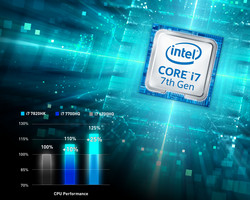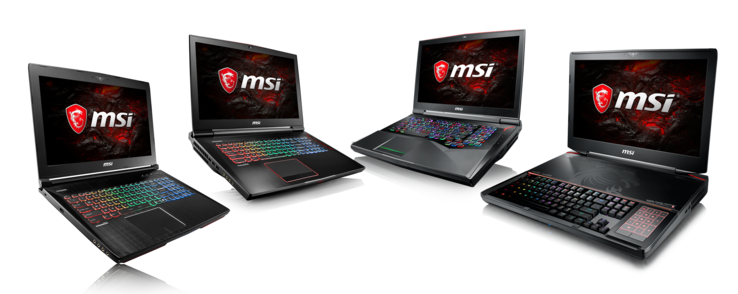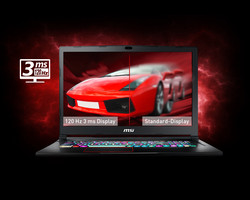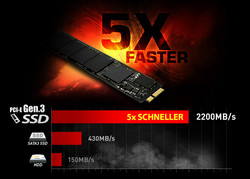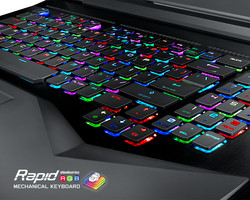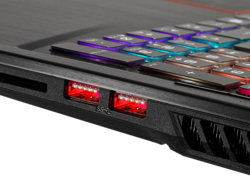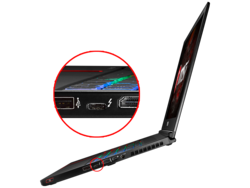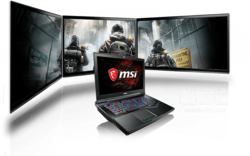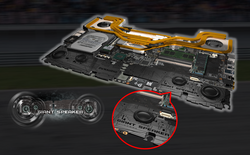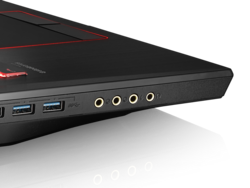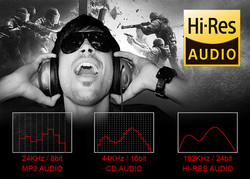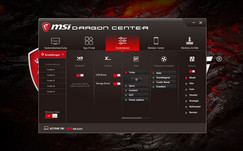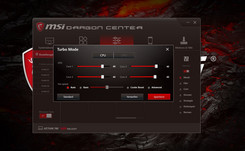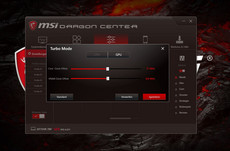Shopping Guide – the Perfect Gaming Notebook
Just a few years ago, many gamers eyed gaming notebooks suspiciously from a safe distance. Today, portable gaming is the latest trend in mobile computing. In addition to being smaller and portable than powerful desktop PCs, modern gaming notebooks are on a par with them in regard to performance. Nvidia’s latest 10-series GeForce GTX GPUs have finally managed to close the gap between mobile and desktop gaming platforms. Not only their names are identical across platforms but so is performance and architecture. Now’s the time to switch, but what should one look for when purchasing a gaming notebook and how can mistakes be avoided? This article illustrates the characteristics of gaming notebooks and their specific technology, and ends with some tips on how to maintain maximum fun with one's brand-new gaming notebook.
Content
First Things First: What Do I Want?
Processor: the Holy Quaternity
Graphics Card: Critical Criterion
Cooling: Concealed Headliner
RAM: Gimme More!
Display: It's All a Matter of Speed
SSD and HDD: System Accelerator and Data Center
Keyboard: Portable Gaming Comfort
Network: Getting Rid of Lag
Connectivity: the More the Merrier
Sound: Acoustic Adversary Localization
Apps and Tools: Powerful Helpers
Additional Information
First Things First: What Do I Want?
Gaming notebooks are not all alike, and the most important and basic question is: what do I really want? A notebook for gaming, that one is obvious, but what exactly am I looking for? A notebook that will be used mostly at home as a desktop replacement computer and only occasionally taken out of the house for a LAN party or some gaming with friends? Alternatively, a small and light powerhouse that will be used for school or work during the day and that leads a secret second life as a gaming notebook at night and on the weekends? MSI alone has more than ten different gaming notebook series with a multitude of different configurations on offer that should fulfill anyone’s individual requirements just fine. It is important to first seriously contemplate one’s needs, requirements, and wishes before making any purchasing decisions.
Processor: the Holy Quaternity
First and foremost, we must look at the processor. In addition to the graphics card, the central processing unit is the most important component defining performance. Most gaming notebooks will be equipped with an Intel Core i7 quad-core processor, most commonly the Core i7-7700HQ. Performance enthusiasts may want to consider an overclockable K-class i7 processor, such as the Core i7-7820HK with unlocked multiplier for easy overclocking to get the most out of one’s system. The MSI GT83VR and GT75VR Titan gaming notebooks are equipped with this particular microprocessor, and tools such as MSI Gaming Center can help with overclocking these CPUs.
Intel CPUs with a U in their name, for example, the Core i7-8550U, are categorized as ultra-low-voltage, or ULV, processors with reduced clock speeds and voltages. These CPUs are usually optimized for more compact Ultrabooks. Because of their lower price tag, they make their way into bigger notebooks occasionally and can most commonly be found in cheaper models. Given their designation, U-class processors are not really made for gaming.
Graphics Card: Critical Criterion
The singularly most important criterion of any gaming notebook is its graphics processing unit or GPU. The GPU is the main factor when it comes to performance that is usually measured in frames per second. Currently, Nvidia’s GeForce GPUs are the leading choice for gaming purposes. Any gaming notebook GPU’s name should start with GTX since adequate performance starts around a GTX 1050 graphics card. For VR purposes (HTC Vive, Oculus Rift) a GTX 1060 GPU is the bare minimum, and the “bigger” GeForce GTX 1070 and GeForce GTX 1080 Chips are faster still and required for maximum details or gaming in 4K.
What is Max-Q?
Since mid-2017, GeForce GTX 1070 and 1080 GPUs have been available as Max-Q models in addition to their regular counterparts. Max-Q GPUs have been specifically optimized for thin notebooks. In order to reduce the strain on the usually much weaker cooling solutions of thin notebooks, these chips run at reduced clock speeds. The balance between performance and energy efficiency has been shifted towards the latter. Thus, a GeForce GTX 1080 Max-Q GPU is about as fast as a regular GeForce GTX 1070 CPU (seen benchmarks below this paragraph). Due to identical nomenclature many manufacturers specifically mention Max-Q in their specifications. It is thus of utmost importance to pay special attention to the data sheet since Max-Q GPUs allow for particularly small and thin designs. However, the regular non-Max-Q GPUs are significantly faster and should be favored when looking for maximum performance.
The following chart should help with understanding GPU performance. Given that the GPU plays an important role in the notebook’s price it is important to know one’s requirements and wishes and balance those with one’s budget.
| Battlefield 1 - 1920x1080 Ultra Preset AA:T | |
| NVIDIA GeForce GTX 1080 Mobile | |
| NVIDIA GeForce GTX 1080 Max-Q | |
| NVIDIA GeForce GTX 1070 Mobile | |
| NVIDIA GeForce GTX 1070 Max-Q | |
| NVIDIA GeForce GTX 1060 Mobile | |
| NVIDIA GeForce GTX 1050 Ti Mobile | |
| NVIDIA GeForce GTX 1050 Mobile | |
| Assassin´s Creed Origins - 1920x1080 Ultra High Preset | |
| NVIDIA GeForce GTX 1080 Mobile | |
| NVIDIA GeForce GTX 1070 Mobile | |
| NVIDIA GeForce GTX 1080 Max-Q | |
| NVIDIA GeForce GTX 1060 Mobile | |
| NVIDIA GeForce GTX 1070 Max-Q | |
| NVIDIA GeForce GTX 1050 Mobile | |
| NVIDIA GeForce GTX 1050 Ti Mobile | |
Current notebook GPUs in comparison. Games are running at FHD resolution and maximum details. Around 30 fps are required for a game to be considered smooth, and reduced levels of detail can lead to higher frame rates in order to be enjoyable on less powerful systems. All tests can be found under https://www.notebookcheck.net/Computer-Games-on-Laptop-Graphics-Cards.13849.0.html
Cooling: Concealed Headliner
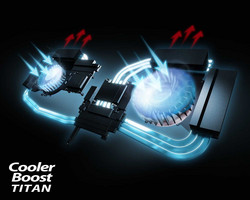
Many buyers pay little to no attention to one of the most important aspects of gaming performance: a notebook’s cooling system. It is of vital importance for any gaming notebook. First and foremost, a gaming notebook’s cooling system needs to dissipate heat from the relevant components quickly and quietly. Second, it is important to understand that modern CPUs and GPUs do not simply run at fixed clock rates but are monitoring their temperatures constantly to maximize frequencies in accordance with their respective thermal envelopes. This includes turbo boost speeds that allow for higher clock speeds as long as temperatures are within their defined range. Thus, more efficient cooling solutions lead to higher clock speeds and better performance. Hefty desktop replacement notebooks with powerful cooling solutions are the best choice for users looking for maximum performance for an ultimate gaming experience.
To illustrate the cooling requirements further let us look at a typical gaming notebook. High-end gaming notebooks manage to produce up to 170 W of thermal loss for CPU and GPU alone. This equals the heat dissipation of two conventional light bulbs, and everyone who has touched one knows how hot a light bulb can get. Only in the gaming notebook’s case this heat has to be dissipated from a thin enclosure, which requires profound expertise and a very high level of cooling solution sophistication to ensure low temperatures while remaining quiet at the same time. Unfortunately, cooling solutions are not visible from the outside and remain outside of potential buyers’ reach. MSI’s Cooler Boost technology features at least two separate cooling units in order to ensure proper and individual CPU and GPU cooling. Heat pipe technology is used to transport heat away from the chips as quickly as possible. “Cooler Boost Titan” (GT series), “Cooler Boost 5” (among others GE series), and “Cooler Boost Triton” (GS series) are the respective individual cooling solutions optimized for these individual hardware requirements.
RAM: Gimme More!
Modern CPUs feature an on-die memory controller defining type and speed of supported random access memory. Intel’s current 7th generation Core processors (for example the aforementioned Core i7-7700HQ) support fast DDR4 memory with up to 2,400 MHz, although many OEMs don’t list memory speeds for their notebooks. An entry-level gaming notebook should be equipped with at least 8 GB of RAM, and 16 GB should be more than enough for all games. 32 GB are not necessary right now but will offer some extra headroom for the future. MSI’s GT series gaming notebooks offer four memory slots and support up to 64 GB of RAM for high-performance gaming enthusiasts to fully enjoy graphically intensive games like Assassin’s Creed Origins, GTA 5, or Far Cry Primal. Any single game will be more than happy with 16 to 32 GB of RAM, and more memory will only be required for extensive multitasking.
Display: It’s All a Matter of Speed
In order for games to really shine a high-quality gaming-compatible display is required. Its speed is not only relevant for first-person shooters: slow screen layout will lead to stutters and smears across the entire image for fast movements. In addition, input lag can lead to prolonged response times if the display is incapable of keeping up with the user’s fast movements. High-quality gaming displays for desktop PCs will almost always support high refresh rates, and MSI’s current lineup features 120 Hz displays throughout all of its gaming notebook series (GF/GP mainstream series and above). Not only do these displays support refresh rates of 120 Hz but also very fast 3 or 5 ms response times to boot. Quick response times are of particular importance for high-frequency displays since the LCD cells need to be able to redraw quickly to react to ever-changing content. A 120 Hz display requires response times of less than 8.3 ms, and 144 Hz is only feasible at response times of 6.9 ms or less. Thus, when purchasing a gaming display with high refresh rate, make sure to ensure that it offers adequately fast response times as well.
SSD and HDD: System Accelerator and Data Center
A well-known issue: operating system, games, and applications take too long to start. In addition, games take up precious hard disk space. The solution is simple: a gaming notebook should always be equipped with a fast SSD for the operating system as well as a big 2.5-inch HDD for additional data. This combination will not only offer sufficient space for one’s data but will also ensure fast loading times to reduce unnecessary waiting times while launching a game or loading the next level.
M.2 SSDs are compact and fast. They do not take up much space and can be connected via either SATA or the much faster PCI Express (PCIe) bus. A PCIe x4 connection will allow data transfer speeds of up to 2,200 MB/s, and therefore up to 5x as much as a regular SATA III SSD. In return, SATA SSDs are usually cheaper and are still a very good choice. The performance difference, when compared with a standard hard disk, is still staggering. It is important to make sure that a gaming notebook can be equipped with an M.2 SSD in the future once the higher capacity M.2 SSDs become more affordable. Every single one of MSI’s gaming notebooks offer an M.2 SATA/PCIe slot. It is also important to note that MSI notebooks can be opened and upgraded without affecting the device’s warranty (2 years pickup & return) assuming a professional execution without, for example, damaging the hardware.
Look out for NVMe
One aspect to pay special attention to is that not all PCIe SSDs are created equal. Faster models support NVM Express (NVMe, or non-volatile memory) that has been specifically optimized for SSDs. SSDs without support for NVMe are accessed via the much slower AHCI legacy protocol.
Super RAID 4 Extra Turbo
If the fastest PCIe SSDs are still not fast enough, you might want to take a closer look at the MSI GT83VR Titan or GT75VR Titan. These two support a feature referred to as “Super RAID 4” on top of NVMe. Basically, it allows combining two fast SSDs into a RAID0 stripe set for double the capacity and transfer rates of up to 3,300 MB/s.
Keyboard: Portable Gaming Comfort
The keyboard is the most important interface between gamer and game. Response times, keyboard resistance, actuation force, travel, and robustness need to be optimized for gaming to survive the demanding requirements of games. MSI has opted to cooperate with SteelSeries to ensure the highest comfort and precision for their mobile gaming series.
One of the most eye-catching features of MSI’s SteelSeries keyboards is the multicolored keyboard backlight. Some might consider it a useful feature for LAN parties or gaming late at night, others might enjoy the play of colors. Either way, the keyboard is certainly pretty flamboyant. Particularly interesting are the MSI GT83VR Titan, GT75VR Titan, GE73 and GE63 Raider series with their individually lit keys for the first time ever in a notebook. The lighting effects can be configured via an application called “SteelSeries Engine 3”, which features a multitude of various effects. A feature called “GameSense” allows using the keyboard backlight to interact with the currently played game to display extra information, such as health or ammunition level, via backlight color coding.
Network: Getting Rid of Lag
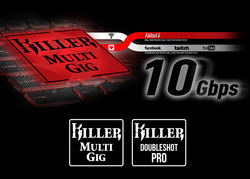
Lag is a gamer’s biggest nemesis and at the same time a welcome excuse when things go south. Obviously, network technology is incapable of increasing speeds and lowering ping times of one’s DSL connection, but a proper combination of hard- and software can at least ensure a high efficiency on the client’s side, and it can make the most out of the available bandwidth. For example, it can prioritize gaming traffic over background traffic such as anti-virus software or email applications to ensure an optimal gaming experience.
Network chips by Killer are optimized specifically for gaming prioritization. The “Killer DoubleShot Pro” enhances both wired and ac wireless connections. It can multiplex bandwidths or assign specific applications to specific network adapters. Killer’s SHIELD chip is an MSI exclusive feature. It prevents jitter and lowers overall response times.
MSI went a step further with the GT75VR Titan for maximum network bandwidth by implementing Killer’s Multi GIG technology: the first ever 10 Gbit Ethernet connection on a gaming notebook.
Connectivity: the More the Merrier
Another important aspect is the notebook’s ports, including its USB ports. Starting with USB 3.0 with its famous Type-A connector, genuine speeds of up to 400 MB/s should suffice for most external storage media. USB 3.1 Superspeed+ (also known as USB 3.1 Gen 2) doubles the available bandwidth and offers up to 800 MB/s. Another improvement came around the same time as USB 3.1 Gen 2: the reversible USB Type-C connector. A modern gaming notebook should offer at least one future-proof USB Type-C as well as three legacy USB Type-A ports to ensure connectivity in the present and the future.
On top of USB, Intel’s Thunderbolt 3 is more versatile and much faster to boot. Based on the USB Type-C connector Thunderbolt 3 ports offer up to 40 GBit/s, support USB 3.1 Gen 2, and carry a 4K DisplayPort signal (optional adapter required). MSI’s GT83, GT75, GT73 Titan, GS73 and GS63 Stealth series support Thunderbolt 3.
Working and Gaming on Multiple Displays
A gaming notebook can be used as a full-fledged gaming platform at home by connecting external (4K) displays via HDMI or DisplayPort. HDMI and DisplayPort are interchangeable and can be converted into one another by use of adapters. Multimonitor configurations allow for an extended Windows desktop for a panoramic view and extra ease of use. In addition to the notebook’s integrated display MSI gaming notebooks support up to two external displays connected via HDMI or DisplayPort, or even up to three external displays on Thunderbolt 3 enabled models. Thanks to “MSI Matrix Display”, up to four displays can be used simultaneously.
This extended field of view can be used for super intensive gaming sessions as well. The latest GT series gaming notebooks support surround gaming on up to three 4K/60Hz displays at the same time that can be connected via HDMI, DisplayPort, and Thunderbolt 3.0.
Sound: Acoustic Adversary Localization
High sound quality is very important for an immersive gaming experience in order to hear one’s enemies long before you can see them. In addition to good notebook speakers, the components creating the analog sound signal are of major importance as well.
More Headroom for Extra Volume
MSI’s most recent GE73 and GE63 Raider series notebooks feature particularly strong and powerful speakers. Just like on the GT series, the speakers have been developed in collaboration with sound specialists Dynaudio. What makes these speakers special is the extra headroom for increased volume. When developing and designing a notebook, the speakers are usually one of the last aspects that have to be integrated into an, at this point, already existing layout. In this particular case, the sound system was one of the first considerations when designing the chassis, and its speakers referred to as “Giant Speakers” are 3x as large and offer up to 5x more resonance volume for increase bass and a higher maximum volume. Thus, despite their compact and small cases the GS73VR and GS63VR feature high-end sound capabilities.
ESS Sabre Hi-Fi Audio DAC
The difference between affordable onboard sound systems and dedicated high-end sound cards is very noticeable. Before gaming sounds make their way to the analog headphones they must first be rendered in the sound chip and converted into an analog sound signal. MSI’s gaming notebooks feature a dedicated ESS Sabre Digital-Analog-Converter that can most commonly be found in high-end Hi-Fi audio equipment. The GT75VR and GT83VR’s sampling rate of up to 32 bit/384 kHz and 122 dB(A) signal-to-noise ratio is up to 15x more accurate when compared with an audio CD. Combined with the included amplifier with decoupled audio circuitry the resulting sound signal is clear, undistorted, and of low noise. The gold-plated audio jacks support precise gaming output as well as Mark Knopfler’s guitar in Hi-Res audio mode. Supported impedances of 16 - 600 ohm allow for the use of high-end headphones and headsets.
Software
In addition to the high-quality audio hardware, a software feature called “Nahimic Audio Enhancer 2+” offers optimized sound output and even supports virtual surround sound via stereo headphones or speakers. The sophisticated audio algorithms make for a perplexingly good 3D sound experience. Thanks to “Nahimic VR” even the multi-channel engine of modern VR games can be channeled into stereo speakers for a more intensive VR experience. In-game localization of enemies is a breeze thanks to virtual ambient sound and in-game communication is enhanced through noise suppression technology. A feature called “Sound Tracker” even supports visualization of sound sources.
Apps and Tools: Powerful Helpers
Last but not least, a well-maintained software environment is also very important for an enjoyable gaming experience. MSI notebooks offer a plethora of useful apps and tools to further optimize and simplify your personal gaming experience.
The control center is MSI’s “Dragon Center” software. It supports extensive support of all relevant features under a single homogenous user interface. Among others, it features direct access to all relevant apps (app portal), monitors system performance in real-time (system monitor), configures the LED effects (LED wizard), allows you to optimize various system parameters (system tuner), and offers quick access to helpful resources should further questions arise (tool & help). The application can even be accessed via smartphone or tablet (Mobile Center) and thus allows the laptop to be controlled and configured remotely.
MSI’s “SHIFT” technology allows adjustment of the balance between maximum performance and minimum noise emissions. Five profiles can be selected depending on one’s individual requirements and gusto to select between maximum system performance and maximum battery life.
The »Dragon Center« is MSI's central control center containing various settings.
Additional Information
MSI’s gaming notebooks offer a multitude of features and specialties, and this article can only skim the surface despite its length. Those who would like to learn more can follow these links for further information. MSI’s bundles for this winter are of particular interest since they offer useful gaming accessories in addition to powerful gaming notebooks.
Models and Price Comparison
GT83VR and GT75VR Titan series
GT73VR and GT62VR Dominator series
GS73VR and GS63VR Stealth series
GE73 Raider series
GE63 Raider series






